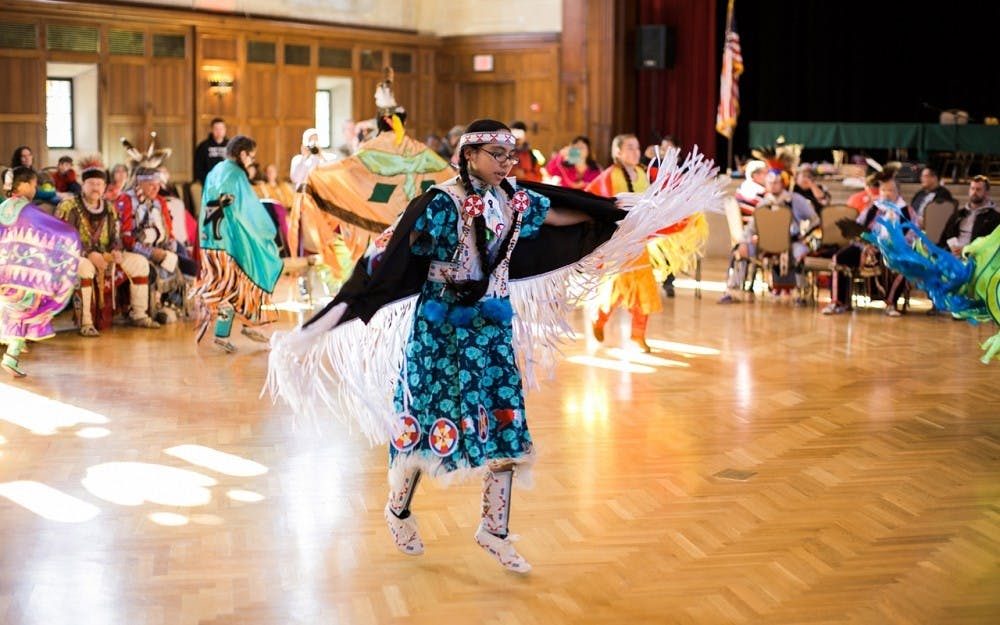The seventh annual IU Traditional Powwow will take place from 10 a.m. to 10 p.m. April 7 in Dunn Meadow. The First Nations Educational and Cultural Center, a cultural center on IU’s campus led by the Office of the Vice President for Diversity, Equity, and Multicultural Affairs, will present the powwow.
“The goal of the powwow is to bring people together,” said FNECC program assistant Heather Williams.
Williams said the free event gives Native American people on campus and throughout the state and city an opportunity to be near a collective native people.
The powwow, which will celebrate Native American culture of the past and present, will include Native American music, dancing, food, arts and crafts vendors.
The event will also feature a raptor show from 11 a.m. to noon, showcasing local raptors such as hawks and eagles. John Johnson, a Cherokee basket weaver and retired ethnomusicology and folklore professor, will lead a basket weaving workshop as well.
A Native American taco bar including classic taco toppings on Native American fry bread will be available from noon to 2 p.m.
There will be two dance sessions featuring Native American dance, singing and drumming. The first session is from 1 to 5 p.m., and the second is from 7 to 10 p.m.
Each session begins with a grand entry in which participants, flag bearers, dignitaries and tribal royalty come into the dance arena together, said FNECC director Nicky Belle.
“We usually tell people to make sure to be there for a grand entry to see everyone come together,” Belle said.
Between the dance sessions from 5 to 7 p.m. there will be various dance exhibitions. Paso a Paso, a Latino student dance group will perform a dance workshop. Dancers from the powwow will exhibit their styles of dance, Belle said.
“You will see something cool no matter what time you show up,” Williams said.
Four peformers with drums will come to the powwow. Two of the drums are known as the host drums, while the other two are known as the invited drums.
“This implies that the host drums are generally more experienced, more champion-like and have been to a lot of powwows,” Belle said. “When we need a special song for a dance that has a specific song attached to it we go to the host drums.”
The drums will represent both the northern and the southern style of music during the powwow. The styles are rooted not only by geography, but also by particular tribal traditions, Belle said. The singing has a different vocal aesthetic as northern pitch is much higher and the southern style is a lower and slower style of singing.
This year, the southern host drum will be the Cozad Singers from Hominy, Oklahoma, one of the most famous singing groups for powwows in the United States.
“They have been around for generations,” Belle said. “They are the type of drum group who people will travel to go hear sing because of their extremely impressive knowledge of songs and song history.”
Ho-Chunk Station is the invited northern drum, a term for a performance group gaining experience in powwow drumming. Ho-Chunk Station is a family drum group that has been coming for the last four years, Belle said. They will be putting on a dance exhibition from 6:30 to 7:30 p.m. Friday, April 6, outside of the Target in College Mall.
“This will give the public a preview of what is to come on Saturday,” Williams said.
The mission of the FNECC is is to build a safe, supportive community for Native American students, faculty and staff, particularly the students, Belle said.
Lydia Curliss, FNECC programming and outreach graduate assistant, said another part of the mission is to educate the community about contemporary native issues and research that is happening on campus.
The powwow represents both parts of the mission because it allows our native community to experience a familial gathering, but it also serves as an educational tool for those that come as spectators, Williams said.
"The powwow shows that Native people have contemporary expressions of culture that harken back to historical imagery, but they are not historical figures," Williams said. "It shows that Native people are contemporary.”




